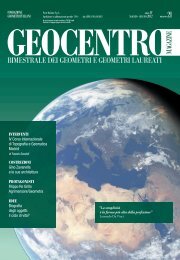Geocentro Magazine - Fondazione Geometri
Geocentro Magazine - Fondazione Geometri
Geocentro Magazine - Fondazione Geometri
Create successful ePaper yourself
Turn your PDF publications into a flip-book with our unique Google optimized e-Paper software.
64<br />
ANNO II | n. 7 | GENNAIO - FEBBRAIO 2010<br />
Sopra: Sir Isaac Newton, Matematico, fi sico e alchimista inglese<br />
A destra:Willebrord Snel van Royen, Matematico, fi sico e<br />
astronomo olandese<br />
Up: Sir Isaac Newton, English mathematician, physicist and<br />
alchemist<br />
Right: Dutch mathematician, Physicist and astronomer<br />
La domanda che echeggia in tutta l’Europa del tempo è:<br />
“La Terra è dunque schiacciata o allungata ai poli?”<br />
Su questo assillo vengono scritte da questo momento le<br />
pagine più belle ed appassionanti della lunga e tormentata<br />
storia della geodesia, proprio in virtù delle forti divergenze<br />
emerse dal confronto tra le teorizzazioni newtoniane ed<br />
i dati sperimentali. E mentre le dispute sembrano essere<br />
arrivate ad un punto morto, giunge nel dibattito geodetico<br />
un contributo del professor Giovanni Poleni (1683 -<br />
1761), docente di astronomia, matematica e filosofia<br />
all’Alma Mater Studiorum di Bologna, dal titolo Epistolae<br />
duae, in quarum altera proponuntur nonnulla de telluris<br />
forma (1724), che pone le basi per la definitiva soluzione<br />
della questione.<br />
Il saggio di Poleni sostiene l’insufficienza del dato<br />
empirico ricavato dalle operazioni di Jaques Cassini<br />
per la confutazione della teoria newtoniana e propone<br />
l’effettuazione di apposite campagne di misura della<br />
lunghezza del grado di longitudine a differenti latitudini,<br />
così da esplorare la variazione della curvatura terrestre in<br />
funzione della latitudine. Tale proposta, tuttavia, ancorché<br />
replichi in modo inconsapevole l’analoga tesi avanzata<br />
precedentemente da Joseph-Nicolas Delisle (1688 - 1768)<br />
was: “Is the Earth a prolate spheroid or an oblate spheroid?”<br />
The most beautiful and interesting pages in the long and<br />
uneven History of Geodesy were written on this topic, as a lot of<br />
different opinions arose on the disagreement between Newton’s<br />
theories and experimental data. While the dispute seemed to<br />
reach a dead-end, Giovanni Poleni (1683-1761), professor of<br />
astronomy, mathematics and philosophy at the Alma Mater<br />
Studiorum - University of Bologna, offered a new contribution<br />
to the debate. He wrote an essay (1724) that proposed the basis<br />
for the final solution to the problem.<br />
He sustained the inadequacy of Cassini’s empirical data in<br />
the refusal of Newton’s theory and proposed new campaigns of<br />
measurement of the length of the longitude grade at different<br />
latitudes, in order to investigate the change of the earth curvature<br />
in terms of latitude. Even if this proposal was similar to the one<br />
previously advanced without success by Joseph-Nicolas Delisle<br />
(1688-1768), four more years had to pass from its second<br />
publication (1729) before Pierre-Louis Moreau de Maupertuis<br />
(1698-1759) took it as the starting point for his Sur la figure<br />
de la Terre (1733). With this last essay he urged the scientists<br />
of the time to solve the “geodetic question”, abandoning the<br />
mere philosophical speculations, useless for any innovation, and<br />
undertaking all the possible practical efforts.<br />
After two years, as a confirmation that longitude had proved






